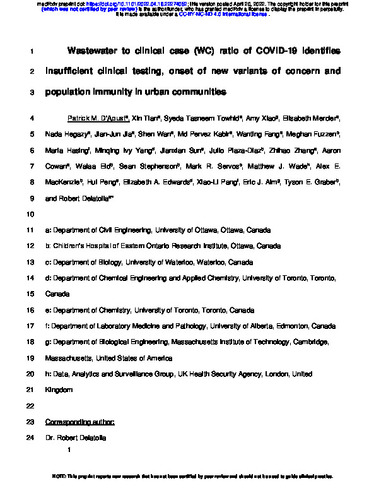| dc.contributor.author | D'Aoust, Patrick M. | |
| dc.contributor.author | Tian, Xin | |
| dc.contributor.author | Towhid, Syeda Tasneem | |
| dc.contributor.author | Xiao, Amy | |
| dc.contributor.author | Mercier, Elisabeth | |
| dc.contributor.author | Hegazy, Nada | |
| dc.contributor.author | Jia, Jian-Jun | |
| dc.contributor.author | Wan, Shen | |
| dc.contributor.author | Kabir, Md Pervez | |
| dc.contributor.author | Fang, Wanting | |
| dc.contributor.author | Fuzzen, Meghan | |
| dc.contributor.author | Hasing, Maria | |
| dc.contributor.author | Yang, Minqing Ivy | |
| dc.contributor.author | Sun, Jianxian | |
| dc.contributor.author | Plaza-Diaz, Julio | |
| dc.contributor.author | Zhang, Zhihao | |
| dc.contributor.author | Cowan, Aaron | |
| dc.contributor.author | Eid, Walaa | |
| dc.contributor.author | Stephenson, Sean | |
| dc.contributor.author | Servos, Mark. R. | |
| dc.contributor.author | Wade, Matthew J. | |
| dc.contributor.author | MacKenzie, Alex E. | |
| dc.contributor.author | Peng, Hui | |
| dc.contributor.author | Edwards, Elizabeth A. | |
| dc.contributor.author | Alm, Eric J. | |
| dc.contributor.author | Graber, Tyson E. | |
| dc.contributor.author | Delatolla, Robert | |
| dc.date.accessioned | 2022-06-15 16:59:29 (GMT) | |
| dc.date.available | 2022-06-15 16:59:29 (GMT) | |
| dc.date.issued | 2022-04-20 | |
| dc.identifier.uri | https://doi.org/10.1101/2022.04.19.22274052 | |
| dc.identifier.uri | http://hdl.handle.net/10012/18385 | |
| dc.description.abstract | Clinical testing has been the cornerstone of public health monitoring and infection control efforts in communities throughout the COVID-19 pandemic. With the extant and anticipated reduction of clinical testing as the disease moves into an endemic state, SARS-CoV-2 wastewater surveillance (WWS) is likely to have greater value as an important diagnostic tool to inform public health. As the widespread adoption of WWS is relatively new at the scale employed for COVID-19, interpretation of data, including the relationship to clinical cases, has yet to be standardized. An in-depth analysis of the metrics derived from WWS is required for public health units/agencies to interpret and utilize WWS-acquired data effectively and efficiently. In this study, the SARS-CoV-2 wastewater signal to clinical cases (WC) ratio was investigated across seven different cities in Canada over periods ranging from 8 to 21 months. Significant increases in the WC ratio occurred when clinical testing eligibility was modified to appointment-only testing, identifying a period of insufficient clinical testing in these communities. The WC ratio decreased significantly during the emergence of the Alpha variant of concern (VOC) in a relatively non-immunized community’s wastewater (40-60% allelic proportion), while a more muted decrease in the WC ratio signaled the emergence of the Delta VOC in a relatively well-immunized community’s wastewater (40-60% allelic proportion). Finally, a rapid and significant decrease in the WC ratio signaled the emergence of the Omicron VOC, likely because of the variant’s greater effectiveness at evading immunity, leading to a significant number of new reported clinical cases, even when vaccine-induced community immunity was high. The WC ratio, used as an additional monitoring metric, complements clinical case counts and wastewater signals as individual metrics in its ability to identify important epidemiological occurrences, adding value to WWS as a diagnostic technology during the COVID-19 pandemic and likely for future pandemics. | en |
| dc.description.sponsorship | Ontario's Ministry of Environment, Conservation and Parks||Alberta Health | en |
| dc.language.iso | en | en |
| dc.publisher | medRxiv | en |
| dc.rights | Attribution-NonCommercial-NoDerivatives 4.0 International | * |
| dc.rights.uri | http://creativecommons.org/licenses/by-nc-nd/4.0/ | * |
| dc.subject | wastewater | en |
| dc.subject | COVID-19 | en |
| dc.title | Wastewater to clinical case (WC) ratio of COVID-19 identifies insufficient clinical testing, onset of new variants of concern and population immunity in urban communities | en |
| dc.type | Preprint | en |
| dcterms.bibliographicCitation | D’Aoust, P. M., Tian, X., Towhid, S. T., Xiao, A., Mercier, E., Hegazy, N., Jia, J.-J., Wan, S., Kabir, M. P., Fang, W., Fuzzen, M., Hasing, M., Yang, M. I., Sun, J., Plaza-Diaz, J., Zhang, Z., Cowan, A., Eid, W., Stephenson, S., … Delatolla, R. (2022). Wastewater to clinical case (WC) ratio of COVID-19 identifies insufficient clinical testing, onset of new variants of concern and population immunity in urban communities (p. 2022.04.19.22274052). medRxiv. https://doi.org/10.1101/2022.04.19.22274052 | en |
| uws.contributor.affiliation1 | Faculty of Science | en |
| uws.contributor.affiliation2 | Biology | en |
| uws.contributor.affiliation2 | Chemistry | en |
| uws.typeOfResource | Text | en |
| uws.peerReviewStatus | Unreviewed | en |
| uws.scholarLevel | Faculty | en |


